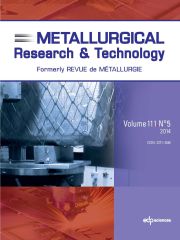Article contents
Effect of carbon content on the reactive sintering of mixed W-Co-C powders
Published online by Cambridge University Press: 15 June 2004
Abstract
During the reactive sintering of W-6%Co-C powder mixtures at 1,500°C under pressure, the reaction product between these elements depends on the relative contents of carbon and cobalt. With a carbon content of 7% by mass, the WC monocarbide forms alone and densification occurs in the presence of a cobalt-based liquid phase. With lower carbon contents, the hemicarbide W2C forms first and reacts with cobalt to form the mixed carbide Co3W9C4. The hardness is increased, but the amount of liquid phase is reduced and the sintering densification is limited. In the presence of the mixed carbide, the cobalt content should be sufficient to be able to produce the amount of liquid phase required for sintering densification. For carbon contents greater than 7%, one obtains the formation of the WC carbide, densified by the cobalt binder, and the precipitation of free graphite. The choice of the initial carbon content allows thus to influence the type of phases obtained and the conditions of liquid phase sintering densification.
- Type
- Research Article
- Information
- Metallurgical Research & Technology , Volume 101 , Issue 5: Science et Génie des Matériaux , May 2004 , pp. 419 - 425
- Copyright
- © La Revue de Métallurgie, 2004
- 5
- Cited by


